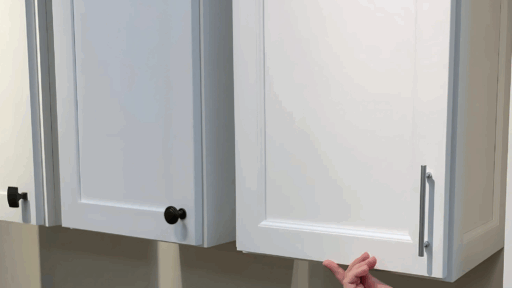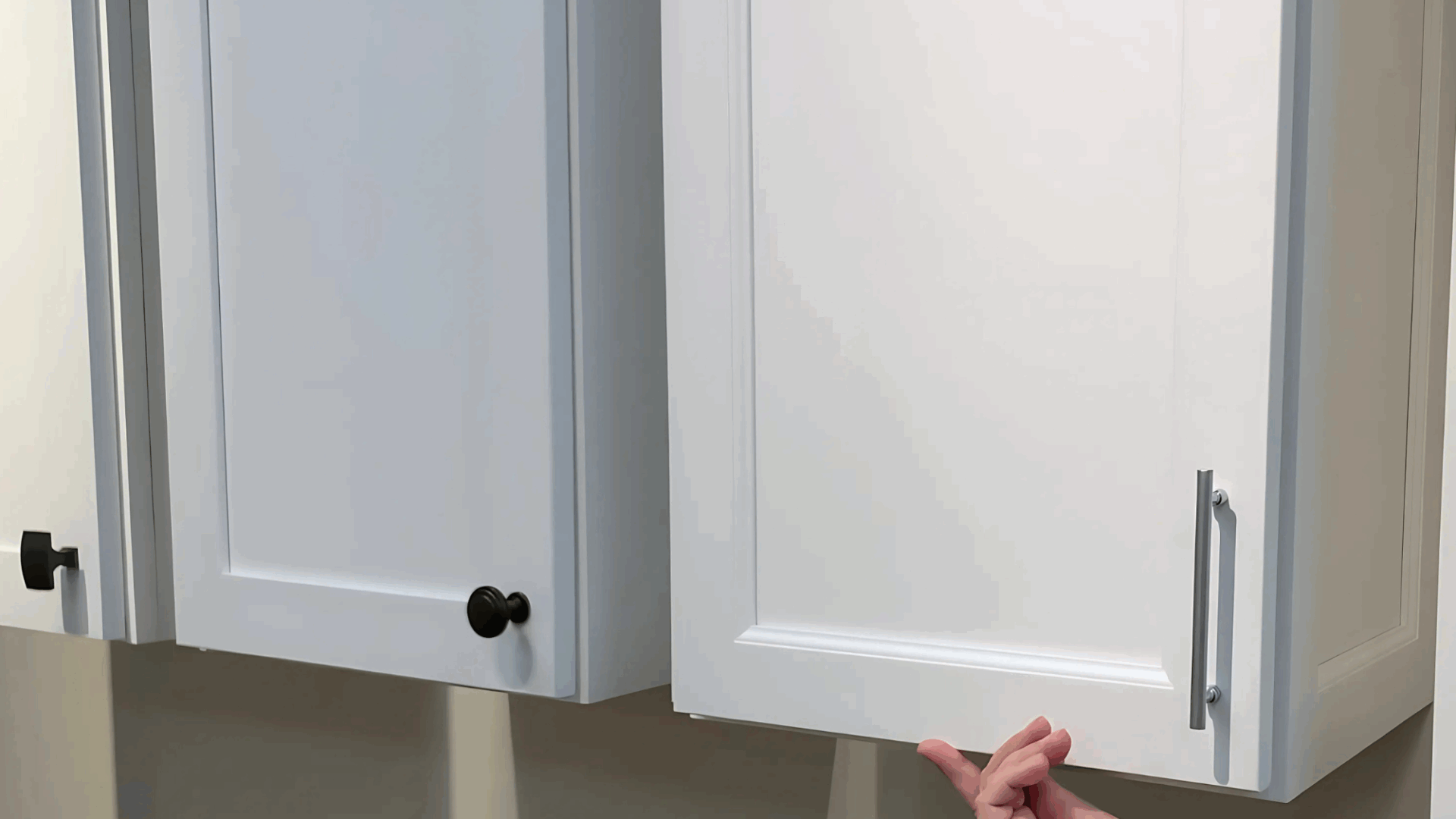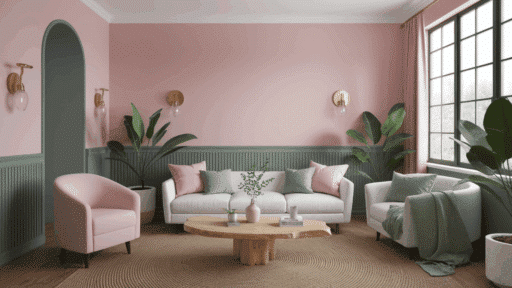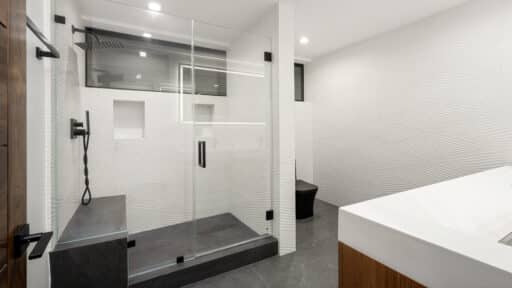Selecting the right cabinet style stands as one of the most crucial decisions in any kitchen or bathroom renovation.
Beyond influencing your space’s visual appeal, this choice directly impacts storage efficiency, installation complexity, and long-term satisfaction with your investment.
These two construction methods differ significantly in their approach to durability, storage optimization, and design flexibility.
Throughout this guide, we’ll examine the construction techniques, style possibilities, and functional advantages of each option.
By understanding how these cabinet types perform in real-world applications, you’ll gain the knowledge needed to select the perfect match for your specific requirements, budget, and design vision.
What Are Framed Cabinets?
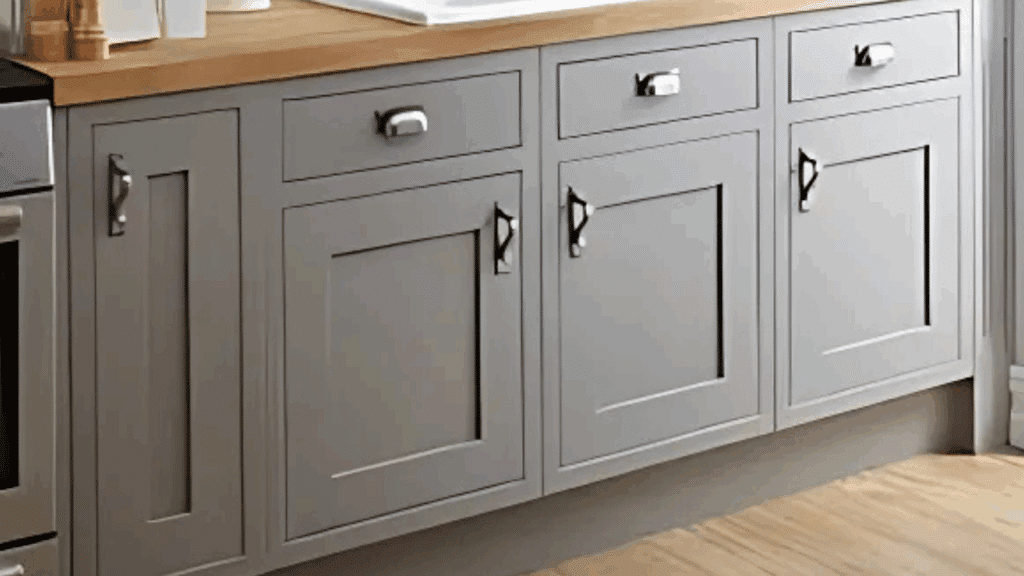
Framed cabinets represent the foundation of American cabinetry, built around a time-tested construction method that has dominated kitchen design for generations.
Construction Details
The heart of framed cabinet construction lies in its perimeter frame system, where a wooden border encases each cabinet box opening.
This frame acts as the primary structural element, distributing weight evenly and providing mounting points for hinges and hardware.
Traditional Build: The frame typically measures 1.5 inches wide and attaches to the front edge of the cabinet box, creating a sturdy foundation that can support heavy doors and withstand decades of daily use.
Materials Used
- Solid hardwood (oak, maple, cherry)
- Medium-density fiberboard (MDF) with veneer
- Plywood with hardwood edging
- Laminated wood products for budget-friendly options
This traditional approach offers exceptional durability and repairability, making framed cabinets a reliable choice for busy households. The frame construction also provides flexibility in door sizing and hardware placement.
Style & Aesthetics
Framed cabinets naturally lend themselves to traditional and transitional design schemes, where the visible frame creates visual weight and lends a classical proportion.
1. Classic Design: The exposed frame creates a furniture-like appearance that works particularly well in farmhouse, Shaker, and traditional kitchen styles. This construction method allows for intricate details like beading, routing, and decorative molding that enhance the cabinet’s visual appeal.
2. Door Styles: Framed cabinets accommodate various door configurations, from raised panel doors that create rich texture and dimension, to flat panel designs that offer clean lines while maintaining the frame’s structural benefits.
What Are Frameless Cabinets?
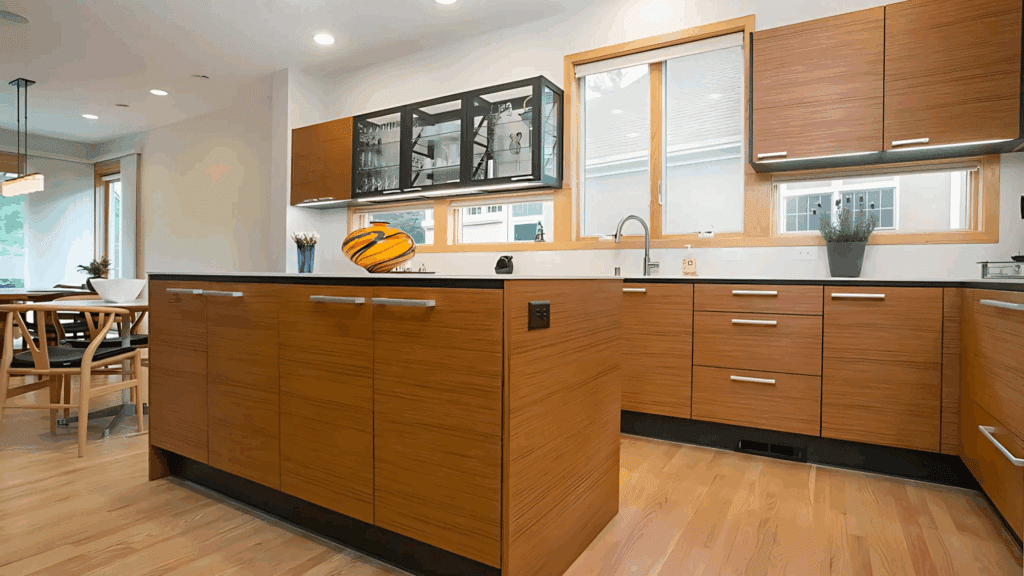
Frameless cabinets eliminate the traditional front frame entirely, creating a clean, uninterrupted opening that maximizes both visual impact and functional access.
Construction Details
Born from European design philosophy, frameless cabinets focus on precision engineering and space optimization rather than traditional craftsmanship methods.
The cabinet box itself becomes the primary structural element, requiring thicker materials and more precise construction techniques.
European Influence: This construction method originated in post-war Europe where space efficiency was paramount, leading to designs that maximize every inch of storage capacity.
Materials Used
- Thick plywood (typically ¾ inch) for structural integrity
- High-quality particleboard with melamine coating
- Medium-density fiberboard with durable finishes
- Engineered wood products designed for precision construction
The thicker cabinet walls compensate for the missing frame, while specialized hardware systems ensure proper door alignment and smooth operation.
Style & Aesthetics
Frameless cabinets create a streamlined appearance that emphasizes clean lines and uncluttered surfaces.
The absence of visible frames allows the cabinet doors to become the primary design element, creating a more cohesive and contemporary look.
1. Modern Appeal: The flush-mounted doors create a sleek, geometric appearance that complements contemporary, transitional, and minimalist design styles. This construction method allows for horizontal grain patterns and book-matched wood veneers that would be interrupted by traditional frames.
2. Simple Doors: Frameless construction naturally pairs with flat-panel doors that emphasize material beauty and craftsmanship over ornate details, creating a sophisticated aesthetic that relies on proportion and quality rather than decorative elements.
Comparing Construction, Style, and Functionality: Framed vs. Frameless Cabinets
This table highlights the differences between framed and frameless cabinets in construction, style, and functionality to help you make a more informed decision.
| Aspect | Framed Cabinets | Frameless Cabinets |
|---|---|---|
| Durability & Strength | Strong due to the additional frame, but may require more support. | Built with thicker panels to compensate for the lack of a frame. |
| Interior Space | The frame reduces usable space inside the cabinet, but offers additional structural support. | Full access to interior space, ideal for those seeking maximum storage. |
| Ease of Assembly | Easier for DIYers due to the structure of the frame. | Requires precise craftsmanship, often best for professional installation. |
| Customization | More opportunities for detailed trims and accents. | Offers sleek, unbroken lines for a seamless, uniform look. |
| Storage Capacity | Slightly reduced interior space, still offers plenty of options for organized storage. | Larger interiors, more accessibility, and room for taller items. |
| Ease of Access | Doors may block some access to the interior, depending on the design. | Full access to the inside, making it easier to retrieve stored items. |
| Maintenance | Slightly harder to clean around the frame and hinges. | Easier to clean as they don’t have a frame obstructing access. |
Cost Considerations: What’s Right for Your Budget?
Understanding the financial implications of each cabinet style helps you make an informed decision that balances upfront costs with long-term value.
The price difference between framed and frameless cabinets stems from the complexity of manufacturing, material requirements, and installation demands.
Framed Cabinets
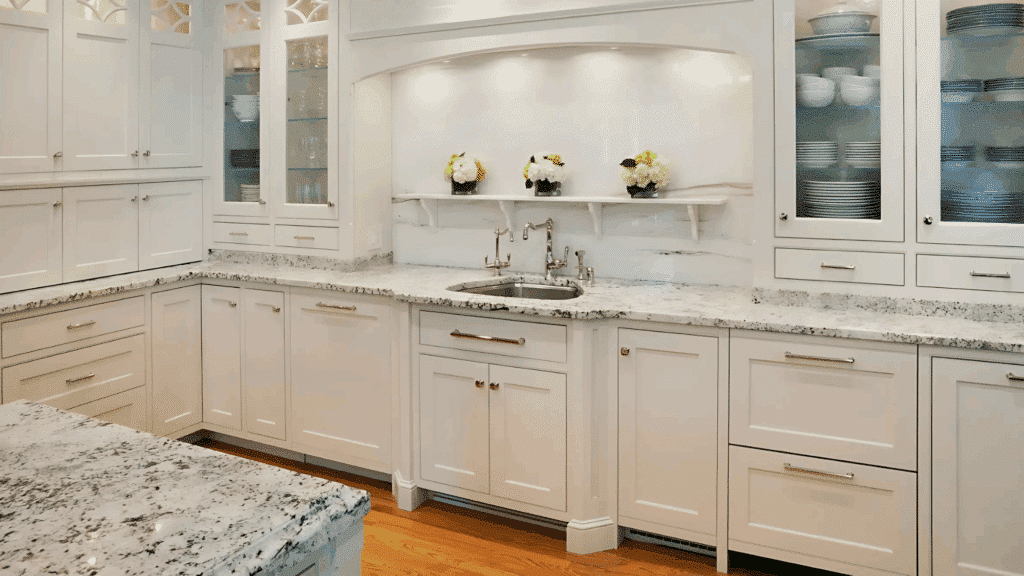
Framed cabinets typically cost 15-25% less than their frameless counterparts, making them an attractive option for budget-conscious homeowners.
The face frame construction allows manufacturers to use thinner cabinet box materials (typically ½ inch) since the frame provides structural support. This reduces material costs while maintaining durability.
Installation costs remain lower because framed cabinets offer more flexibility in fitting irregular spaces. The frame can be scribed to walls, and minor gaps can be concealed with trim, reducing the need for perfect measurements and custom modifications.
Frameless Cabinets
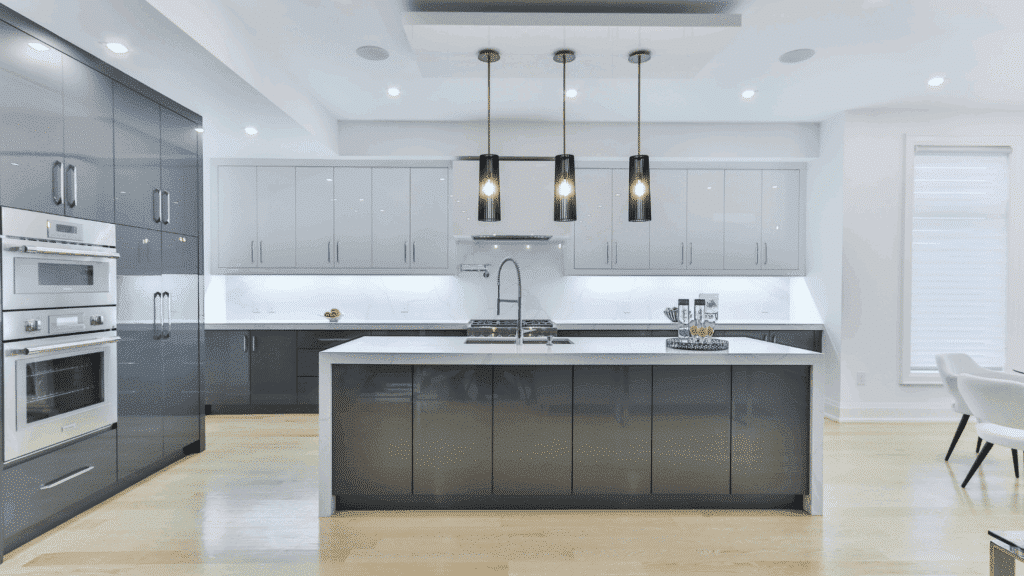
Frameless cabinets command a premium price, typically 20-30% higher than framed alternatives, due to the precision manufacturing requirements and specialized hardware systems.
European-style hinges and drawer slides, while superior in performance, cost significantly more than standard hardware.
These precision components require precise placement and adjustment, which contributes to both material and labor costs.
However, the superior space efficiency can offset costs by potentially reducing the total number of cabinets needed. The additional storage capacity may eliminate the need for supplementary storage solutions, providing indirect savings.
Long-Term Investment
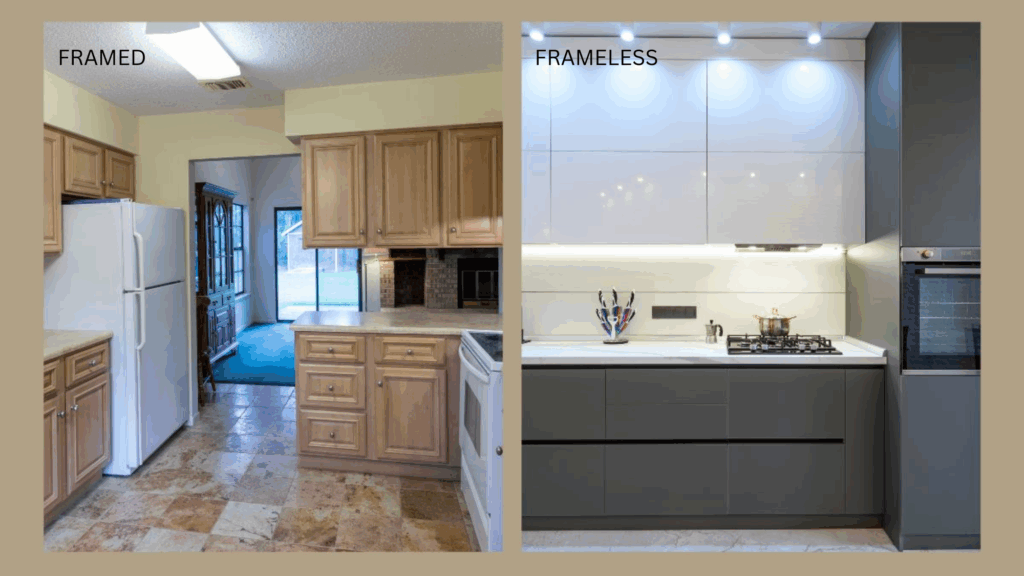
Both cabinet styles offer distinct advantages for retaining long-term value.
Framed cabinets provide easier repair and refinishing options, as frame components can be replaced without affecting the entire structure. This extends the cabinet’s lifespan and reduces maintenance costs over time.
Frameless cabinets excel in functional longevity through superior hardware systems that maintain smooth operation for decades.
The precision construction and high-quality materials often outlast traditional alternatives.
Resale value considerations favor both styles depending on market preferences. Traditional markets often prefer framed cabinets, while contemporary-focused buyers typically value frameless designs more highly.
Installation and Maintenance
1. Framed cabinets offer DIY-friendly installation thanks to their forgiving construction that accommodates wall irregularities and measurement variations.
The face frame conceals minor gaps and imperfections, making them ideal for homeowners tackling their own projects.
2. Frameless cabinets demand professional installation due to precision requirements and specialized hardware systems.
However, once properly installed, they require less frequent maintenance thanks to superior European hinges and drawer slides that maintain smooth operation for decades without adjustment.
Final Thoughts
Choosing between framed and frameless cabinets ultimately depends on balancing your design preferences, functional needs, and budget constraints.
Consider your lifestyle, kitchen usage patterns, and long-term plans when making this decision.
A busy family kitchen may benefit from the extra storage and ease of maintenance that frameless cabinets offer.
Ready to upgrade your kitchen with the perfect cabinet choice? Consult with a qualified kitchen designer or cabinet professional who can assess your specific space, needs, and budget.
Your ideal kitchen awaits, take the first step toward creating the space you’ve always envisioned.

